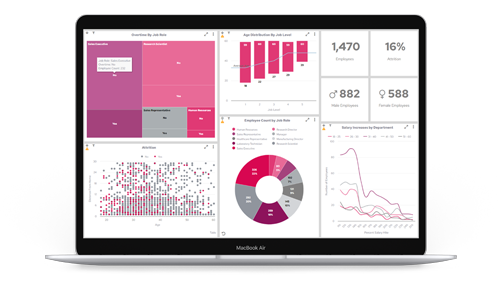It’s hard to imagine our favorite apps without valuable data insights. Think of Strava without its charts showing average speed, heart rate, or how many miles you’ve run over a period of time. Or MailChimp without metrics like open rate, bounce rate, and unsubscribe rate. As valuable as these insights may be, building them out for your app is not something your developers can manage quickly between other tasks. It takes considerable time and effort. Choosing the right embedded analytics tools is crucial for leveraging data-driven insights that can propel your business forward.
Whether you're integrating analytics into a platform or enhancing your existing BI tools, the selection process can be daunting. Here are several key considerations to guide you through evaluating potential analytics software vendors effectively.
What are embedded analytics tools?
You're well aware of the importance of data in driving business decisions. But how can you make this data more accessible and actionable for your users?
This is where embedded analytics tools come into play. Embedded analytics integrates powerful data visualization tools directly into your application, providing users with real-time insights without the need to switch between platforms. It’s a seamless way to enhance the value of your software by enabling data-driven decision-making right where the action happens.
When considering embedded analytics tools, it’s crucial to understand what it entails. Unlike standalone analytics solutions, embedded analytics is designed to blend in with your existing application, maintaining a consistent user experience. It’s not just about displaying data; it’s about integrating analytical capabilities so deeply into your application that users perceive it as a natural extension of the tools they already use. This integration can lead to increased user engagement, retention, and ultimately, the success of your offering.
Buy or build: Which is better?
When it comes to embedded analytics tools, you have two primary options: buy or build. While building your own might seem appealing for its customization potential, it often requires significant resources, time, and expertise. On the other hand, third-party embedding offers several compelling benefits:
- Speed to market: Third-party solutions are typically ready to deploy, allowing you to integrate analytics quickly without the lengthy development cycles.
- Cost efficiency: Developing an in-house solution can be costly, not just in terms of initial development but also ongoing maintenance. Third-party tools often come with predictable pricing models.
- Expertise and support: Established vendors bring a wealth of experience and offer robust support, ensuring that you can leverage best practices and get help when needed.
- Scalability: Third-party solutions are designed to scale with your business, handling increased data loads and user demands without compromising performance.
- Security and compliance: Reputable vendors adhere to industry standards and regulations, providing peace of mind that your data is secure and compliant with legal requirements.
Tips for evaluating embedded analytics tools
1. Understand your analytics needs
Before diving into the selection process, it's essential to clearly define what you need from an analytics solution.
Consider whether you require embedded analytics tools that integrate seamlessly with your existing applications or if a standalone solution would serve your needs better. Assess the types of data you will be analyzing and the level of customization required. This initial step helps in filtering out vendors that do not align with your specific requirements.
For instance, if your organization operates within a specific model, you might prefer vendors specializing in embedded analytics tools designed specifically for such environments. These solutions can provide more tailored functionalities like user behavior analysis and feature usage statistics, which are crucial for certain platforms.
2. Evaluate integration capabilities
Integration is a critical factor, especially if you are considering embedded analytics tools. The software should integrate smoothly with your existing systems without requiring extensive modifications.
Check if the vendor supports standard APIs and offers comprehensive documentation that assists your development team during the integration process.
Moreover, consider the impact on your existing workflows. The ideal analytics solution should enhance these processes, not complicate them.
For example, embedded analytics tools should offer insights directly within the application, reducing the need to switch between systems and thereby saving valuable time and resources.
3. Scalability and performance
As your business grows, your analytics needs will evolve.
It's important to choose a vendor whose software can scale with your growing data requirements without degrading performance. Inquire about the infrastructure's ability to handle increased loads and the presence of features like load balancing and elastic computing.
Additionally, evaluate the performance of the analytics solution in real-time environments. The ability to process large volumes of data quickly and provide insights in near real-time is essential for making timely decisions.
4. Security and compliance
Data security is paramount, especially when dealing with sensitive customer information.
Ensure that the analytics software complies with relevant industry standards and regulations such as GDPR, HIPAA, or CCPA. Examine the vendor's security protocols, data encryption methods, and their policy on data ownership and access rights.
It's also beneficial to check for any past security breaches and how the vendor handled them. This can provide insights into their security culture and preparedness for potential threats.
5. Cost considerations
Understanding the pricing model of the analytics software is crucial. Some common pricing strategies include per-user licensing, pay-per-query, or subscription-based models. Consider which model aligns best with your usage patterns and budget.
Be wary of hidden costs such as charges for data storage, additional modules, or premium support services. A transparent pricing model not only helps in budgeting but also avoids unexpected expenses down the line.
6. User support and community
Effective support can significantly reduce downtime and enhance user satisfaction. Check the types of support offered by the vendor, such as 24/7 live support, online resources, and community forums. A vibrant user community can also be a valuable resource for troubleshooting, sharing best practices, and learning new ways to use the analytics software.
Additionally, consider the vendor's reputation for customer service. Long response times and inadequate support can hinder your ability to resolve issues swiftly, affecting your operations.
7. Vendor stability and reputation
The stability of the vendor is an often-overlooked aspect of the selection process. Opt for vendors who have a proven track record and solid reputation in the industry. Research their financial health, years in business, and read case studies or testimonials from current users.
Attending industry conferences or webinars can also provide deeper insights into the vendor's expertise and industry standing. Engaging directly with their representatives can give you a clearer picture of their capabilities and customer focus.
8. Demo or trial period
Before making a final decision, request a demo or a trial period to test the analytics software in your own environment. This allows you to evaluate the ease of use, features, and overall compatibility with your existing systems.
During the trial, pay special attention to the user interface and ease of use. The software should be intuitive and require minimal training for your team to become proficient. This reduces the learning curve and accelerates the adoption of the tool across your organization.
Conclusion
Selecting the right embedded analytics tools is a strategic decision that impacts many aspects of your business.
By thoroughly evaluating your needs, assessing integration capabilities, understanding pricing models, and considering vendor stability, you can choose a solution that not only meets your current needs but also supports your future growth.
Remember, the goal is to turn data into actionable insights that drive decision-making and foster a competitive edge.
At Panintelligence, we understand the importance of making informed choices about analytics solutions. While we offer robust embedded analytics tools tailored for various needs, our focus here is to empower you with the knowledge to make the best decision for your unique circumstances.
























